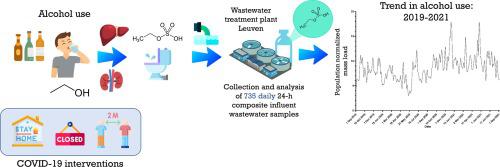Environment International ( IF 10.3 ) Pub Date : 2022-10-02 , DOI: 10.1016/j.envint.2022.107559 Tim Boogaerts 1 , Xander Bertels 2 , Bram Pussig 3 , Maarten Quireyns 1 , Louis Toebosch 1 , Natan Van Wichelen 1 , Catalina Dumitrascu 1 , Catherina Matheï 3 , Lies Lahousse 2 , Bert Aertgeerts 3 , Hans De Loof 4 , Adrian Covaci 1 , Alexander L N van Nuijs 1

|
Wastewater-based epidemiology (WBE) is a complementary approach to monitor alcohol consumption in the general population. This method measures concentrations of xenobiotic biomarkers (e.g., ethyl sulphate) in influent wastewater (IWW) and converts these to population-normalized mass loads (PNML, in g/day/1000 inhabitants) by multiplying with the flow rate and dividing by the catchment population. The aims of this case study were to: (i) investigate temporal trends in alcohol use during the COVID-19 pandemic; and (ii) measure the effect of policy measures on alcohol consumption. Daily 24-h composite IWW samples (n = 735) were collected in the wastewater treatment plant of the university city of Leuven (Belgium) starting from September 2019 to September 2021. This is the first study that investigates alcohol use through WBE for a continuous period of two years on a daily basis. Mobile phone data was used to accurately capture population fluxes in the catchment area. Data was evaluated using a time series based statistical framework to graphically and quantitatively assess temporal differences in the measured PNML. Different WBE studies observed temporal changes in alcohol use during the COVID-19 pandemic. In this study, the PNML of ethyl sulphate decreased during the first lockdown phase, potentially indicating that less alcohol was consumed at the Leuven area during home confinement. Contrastingly, alcohol use increased after the re-opening of the catering industry. Additionally, a decrease in alcohol use was observed during the exam periods at the University of Leuven and an increase during the holiday periods. The present study shows the potential of WBE to rapidly assess the impact of some policy measures on alcohol consumption in Belgium. This study also indicates that WBE could be employed as a complementary data source to fill in some of the current knowledge gaps linked to lifestyle behavior.
中文翻译:

通过基于废水的流行病学评估 COVID-19 对策对酒精消费的影响:比利时的案例研究
基于废水的流行病学 (WBE) 是监测普通人群饮酒量的一种补充方法。该方法测量流入废水 (IWW) 中异生生物标志物(例如,硫酸乙酯)的浓度,并通过乘以流量并除以集水区将这些浓度转换为人口归一化质量负荷(PNML,以克/天/1000 名居民为单位)人口。本案例研究的目的是:(i) 调查 COVID-19 大流行期间饮酒的时间趋势;(ii) 衡量政策措施对酒精消费的影响。从 2019 年 9 月到 2021 年 9 月,在鲁汶大学城(比利时)的污水处理厂收集了每天 24 小时的复合 IWW 样本(n = 735)。这是第一项通过 WBE 连续两年每天调查饮酒情况的研究。手机数据被用来准确捕捉集水区的人口流动。使用基于时间序列的统计框架评估数据,以图形和定量方式评估测量的 PNML 中的时间差异。不同的 WBE 研究观察了 COVID-19 大流行期间酒精使用的时间变化。在这项研究中,硫酸乙酯的 PNML 在第一个封锁阶段有所下降,这可能表明鲁汶地区在居家隔离期间的饮酒量减少了。相比之下,餐饮业重新开放后,饮酒量有所增加。此外,鲁汶大学考试期间饮酒量减少,假期期间饮酒量增加。本研究表明 WBE 有潜力快速评估某些政策措施对比利时酒精消费的影响。这项研究还表明,WBE 可以用作补充数据源,以填补当前与生活方式行为相关的一些知识空白。











































 京公网安备 11010802027423号
京公网安备 11010802027423号